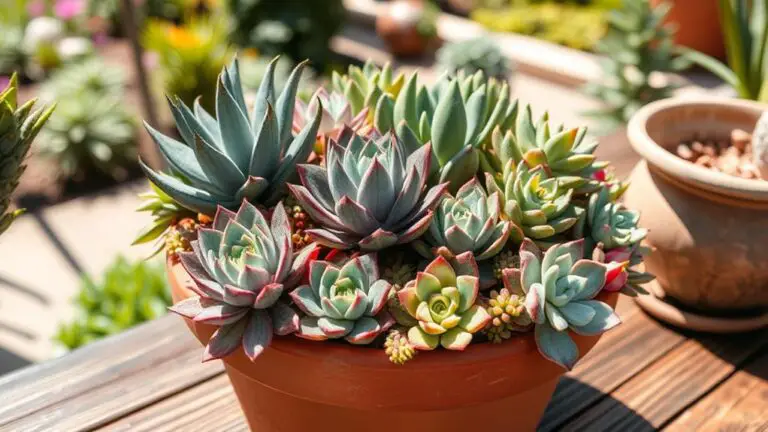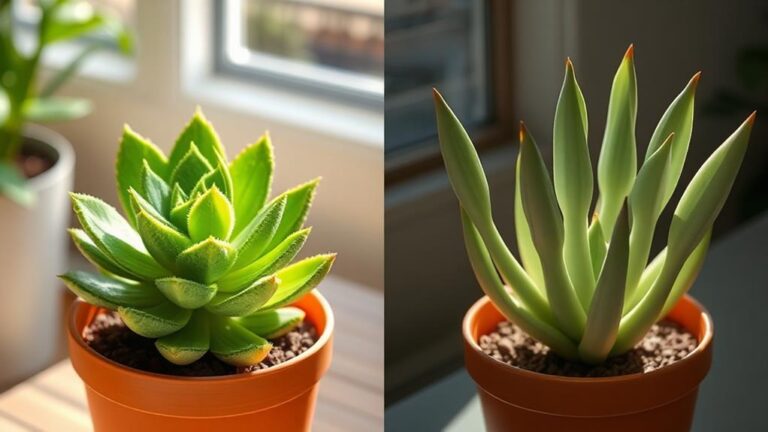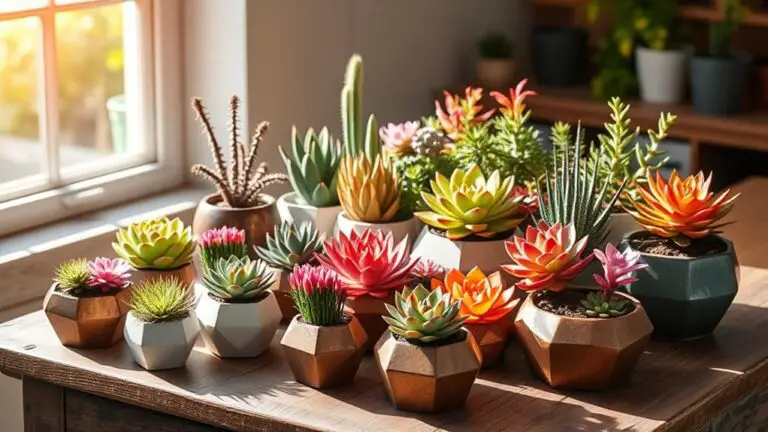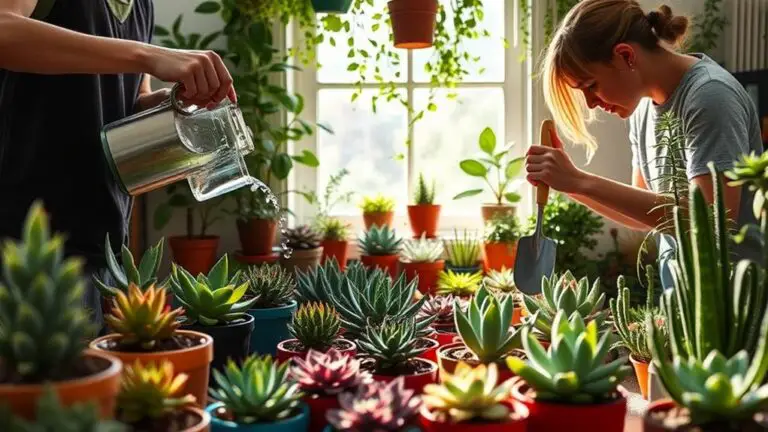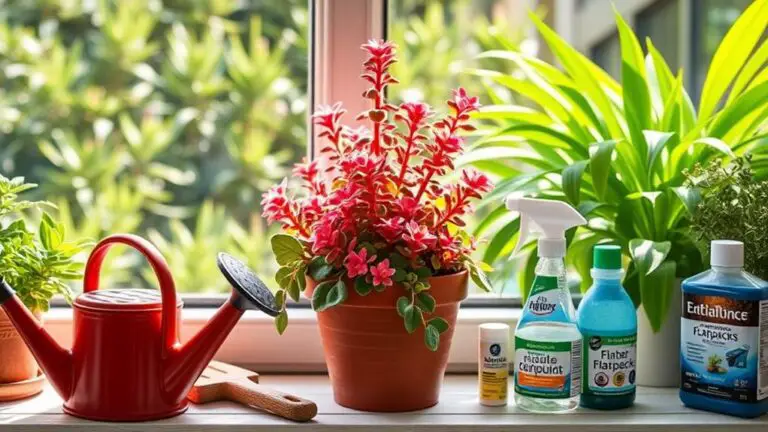7 Steps to Care for Your Sedum Jelly Bean
Caring for your Sedum Jelly Bean starts with choosing the right location, but that's just the beginning. You'll need to take into account the type of soil and pot to guarantee proper drainage, and there's a specific watering schedule to follow. It's also essential to understand the plant's sunlight and temperature needs to keep it thriving. Pruning isn't just for aesthetics; it promotes healthier growth. Plus, you'll want to be vigilant about pests and remove dead leaves regularly. And if you're interested in expanding your collection, there are effective propagation methods to explore. Let's start with how to select the best spot for your plant.
Choosing the Right Location
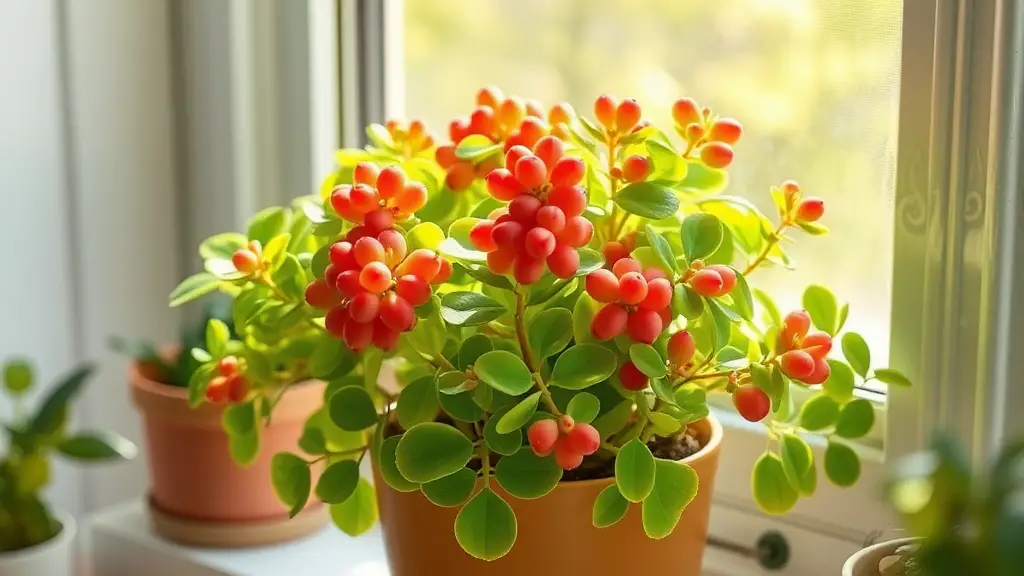
When selecting the perfect spot for your Sedum Jelly Bean, it's crucial to choose a location that offers at least 6 hours of direct sunlight daily.
Jelly Bean plants thrive in bright light, so placing them near a south-facing window can be ideal. This helps guarantee they get the direct sunlight necessary to promote healthy growth and vibrant leaf colors.
If you notice your plant's leaves turning yellow or its stems becoming leggy, it's a sign that your Sedum Jelly Bean isn't getting enough light. In such cases, moving it to a sunnier location can help.
Avoid low-light areas as they can lead to poor growth and may prevent your plant from flowering.
For those growing Jelly Bean plants outdoors, it's important to know that they do best in USDA zones 9-10.
Confirm they receive ample bright light and protect them from freezing temperatures during colder months. If your plant is in a pot, you can move it indoors when temperatures drop.
Soil and Pot Selection

To guarantee your Sedum Jelly Bean thrives, selecting the right soil and pot is essential. Start with a well-draining soil mix to prevent root rot. A combination of cactus mix and perlite, or coarse sand in a 2:1 ratio, works best. This mix guarantees that water doesn't linger around the roots, which could cause problems.
You could also use sandy soil, as Sedum Jelly Bean can adapt to various soil conditions without worrying about pH levels.
Choosing the right pot is just as important. Make certain it has drainage holes to let excess water escape. This helps the soil dry out between waterings, preventing overwatering.
When planting, maintain the original container depth to avoid fungal issues. Don't bury the stems too deep, as this can cause rot.
For peak growth, select a pot that's not too large. A smaller pot confines the roots, encouraging healthy development. It also helps prevent overwatering, a common issue with larger containers.
Proper Watering Techniques
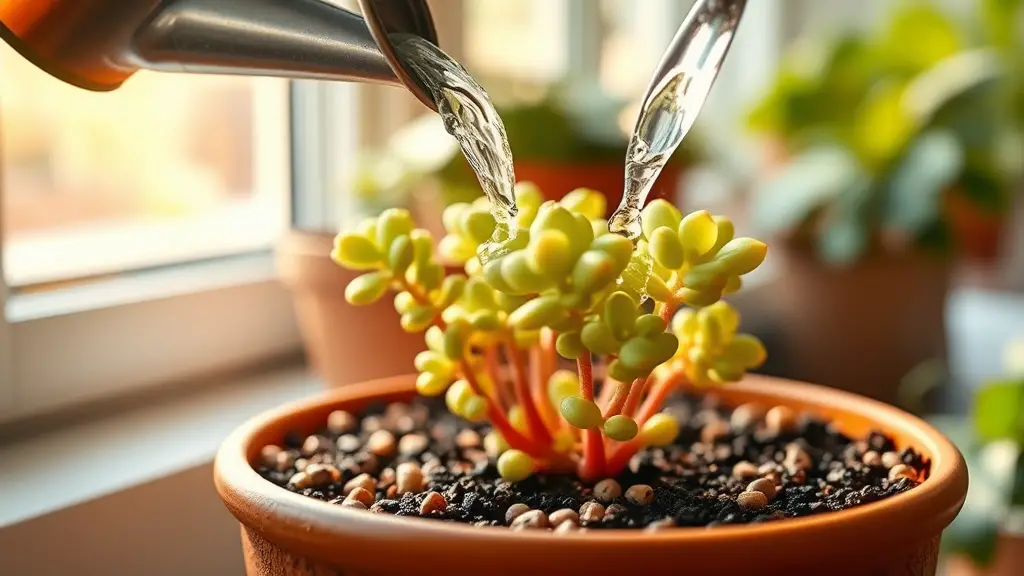
To keep your Sedum Jelly Bean happy, check the top inch of soil for dryness before you water it.
In the summer, give it a deep drink every 7-10 days, but adjust if it's really hot or sunny.
Soil Moisture Check
Before you water your Sedum Jelly Bean, always check the top inch of soil for dryness. This plant prefers to dry out completely between waterings to avoid root rot. You can use a moisture meter or simply stick your finger into the soil to feel for moisture. If the soil feels dry, it's time to water. If it's still moist, wait a few more days and check again.
Watering your Sedum correctly is vital. When you do water, make certain to do it deeply, allowing the water to reach the plant's roots. Verify the pot has proper drainage to prevent water from sitting at the bottom, which can lead to overwatering and root rot.
Overwatering can cause the leaves to become mushy or translucent, a clear sign that your plant is getting too much moisture. It's better to err on the side of underwatering rather than overwatering with Sedum Jelly Beans.
These plants are quite drought-tolerant and can handle dry conditions better than overly wet ones. By taking the time to check the soil moisture, you'll keep your Sedum healthy and thriving. Happy gardening!
Watering Frequency Tips
Wondering how often to water your Sedum Jelly Bean? A good watering schedule is essential for keeping your plant healthy.
During the summer months, water deeply every 7-10 days. When temperatures rise or the plant gets more sunlight, you might need to adjust your watering frequency.
In spring and fall, reduce watering to every 10-14 days, and in winter, limit it to once a month or every 2-3 weeks.
Always check if the top inch of soil feels dry before watering. This helps avoid root rot since Sedum Jelly Beans prefer underwatering to overwatering.
Use a moisture meter or the finger test to make sure the soil is dry enough. This promotes healthy root growth.
Make sure your pot has drainage holes to prevent water pooling at the bottom, which can lead to root rot and other moisture issues.
If you notice the soil is staying wet for too long, adjust your watering routine or check the drainage.
Avoid Overwatering Risks
Even though Sedum Jelly Bean is quite forgiving, overwatering remains one of the most common issues that can jeopardize its health. To avoid this, always let the soil dry completely between waterings. Check that the top inch is dry before adding moisture, as Sedum Jelly Bean is more tolerant of underwatering than overwatering.
Water deeply every 7-10 days during summer, reducing to every 10-14 days in spring and fall, and only once a month during winter. This schedule helps prevent root rot. Use well-draining soil, like a mix of cactus soil and perlite or coarse sand, to minimize moisture retention. Always check soil moisture levels with a moisture meter or by inserting your finger into the top inch of soil before watering.
Here's a quick reference table:
| Season | Watering Frequency | Soil Condition |
|---|---|---|
| Summer | Every 7-10 days | Top inch dry |
| Spring/Fall | Every 10-14 days | Well-draining soil |
| Winter | Once a month | Moisture levels low |
Signs of overwatering include yellow leaves, mushy texture, and root rot. If you notice these, adjust your watering practices and consider repotting in dry soil. By following these tips, you'll keep your Sedum Jelly Bean healthy and thriving.
Sunlight and Temperature Needs

Sedum Jelly Bean thrives in bright sunlight, needing at least 6 hours of direct sunlight daily for ideal growth and vibrant leaf color.
You'll notice that when the plant gets plenty of light exposure, its leaves may turn a beautiful red as a stress response. If it gets less light, the leaves will stay green.
For temperature, aim to keep your Sedum Jelly Bean in a range between 65°F to 80°F (18°C to 27°C) during the day.
At night, cooler temperatures are fine, but try not to let it drop below 50°F (10°C). It's sensitive to freezing, so if you live in USDA zones 9-10, your plant can grow outdoors.
However, in colder climates, you'll need to protect it from the cold.
If you're growing your Sedum Jelly Bean indoors, place it near east, south, or west-facing windows to guarantee it gets enough bright sunlight, especially during the winter months.
Proper light exposure is essential for its best growth.
Pruning and Maintenance

To keep your Sedum Jelly Bean looking its best, regular pruning and maintenance are essential. You should prune leggy stems during the growing season in spring and summer. This encourages bushier growth and helps maintain a compact appearance.
Always use clean, sharp pruning shears or scissors to make cuts. This reduces the risk of introducing pathogens to the plant.
Removing dead leaves is another important step. It promotes overall plant health and prevents potential pest infestations.
Regularly inspect your plant for pests like mealybugs and spider mites. Treat any infestations promptly to keep your Sedum Jelly Bean healthy and thriving.
If you want to expand your succulent collection, consider propagating the cuttings from your pruning efforts. Allow the cuttings to callous for 1-2 days before planting them in well-draining soil. This encourages new growth and helps guarantee successful propagation.
Identifying and Addressing Issues
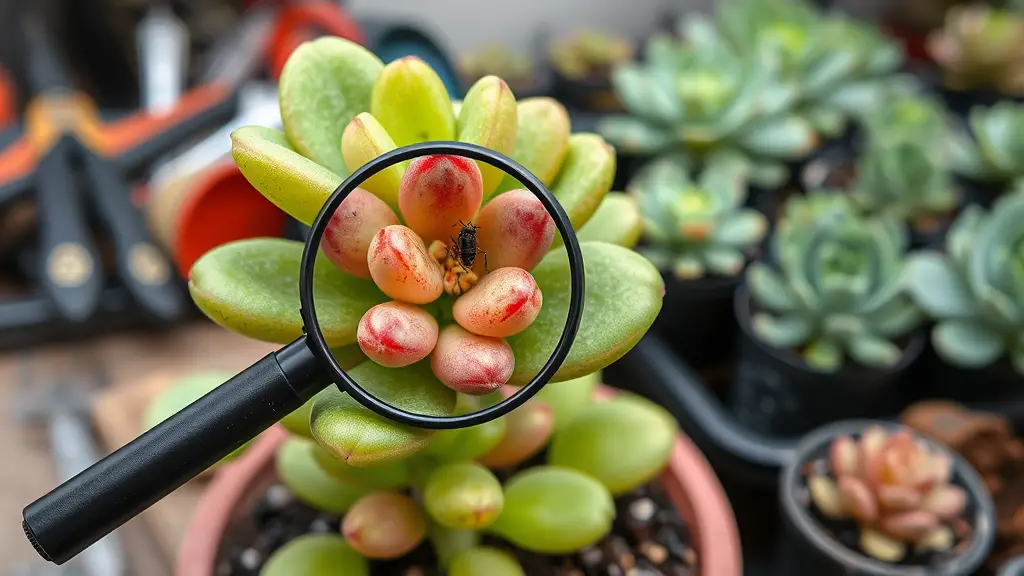
When caring for your Sedum Jelly Bean, it's important to keep an eye out for common issues like pests, watering problems, and light needs.
If you spot yellowing leaves, check if you're overwatering and adjust your schedule.
For leggy growth or falling leaves, move your plant to a sunnier spot, making sure it gets at least 6 hours of direct light each day.
Common Pests Monitoring
While caring for your Sedum Jelly Bean, it's important to regularly inspect the plant for common pests that can cause significant damage.
Mealybugs and spider mites are two pests you should watch out for. If you notice white, cotton-like clusters on your plant, you're likely dealing with mealybugs. Treat them with neem oil or insecticidal soap for effective removal.
Spider mites, on the other hand, may present as tiny webs on the undersides of leaves. To deter these pests, try increasing humidity levels or misting the plant occasionally.
It's also vital to maintain good air circulation around your Sedum Jelly Bean. Proper airflow helps prevent moisture buildup, which can attract pests and lead to fungal issues.
Overwatering is another factor to take into account. A consistent watering schedule is important because overwatering can weaken your plant's defenses, making it more susceptible to pest infestations.
Check the soil regularly to verify it's not too damp, and adjust your watering habits as needed.
Watering and Light Adjustments
After keeping an eye on common pests, it's equally important to focus on proper watering and light adjustments for your Sedum Jelly Bean. This succulent thrives with at least 6 hours of direct sunlight daily. If you notice the leaves turning red, it might be getting too much sunlight; green leaves suggest it needs more light.
Watering your Sedum Jelly Bean correctly is essential. In the summer, water deeply every 7-10 days, making sure the soil dries out completely between waterings. During spring and fall, adjust to every 10-14 days, and in winter, reduce to once a month.
Always check the soil moisture before watering—using a moisture meter or the finger test can help. Overwatering can cause yellow leaves and mushy stems, so provide good drainage and avoid soggy soil.
If your plant exhibits leggy growth or dropping leaves, it likely needs more sunlight. Relocate it to a sunnier spot to help it regain its shape and health.
Propagation Methods
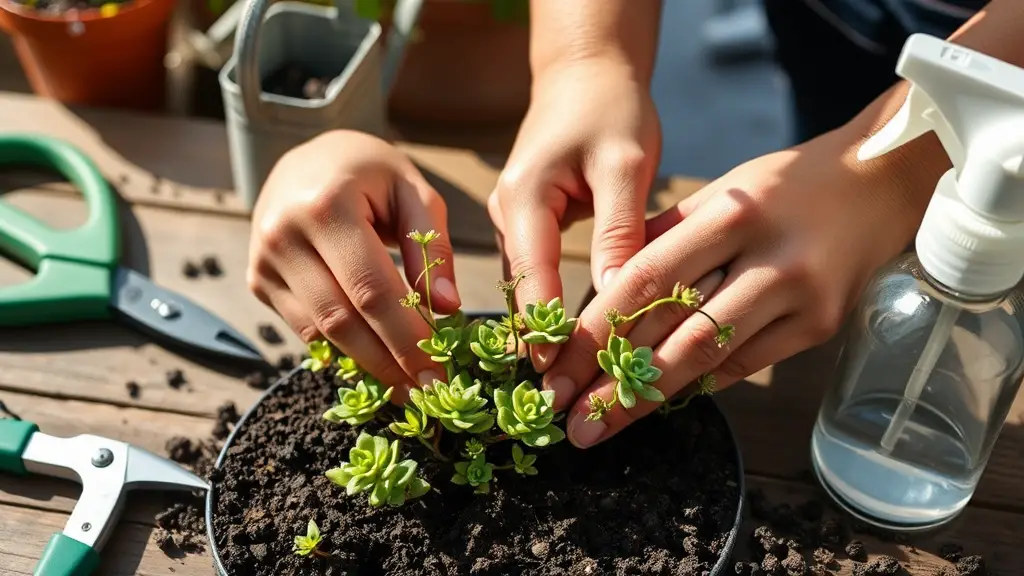
Propagating Sedum Jelly Bean is straightforward and can be quite rewarding. The most popular propagation methods include using stem cuttings, which are easy and effective.
Start by taking healthy stem cuttings and letting them callous for 1-2 days. Then, plant them in well-draining soil. This is essential to prevent root rot. During the growing season, mist the cuttings every few days to encourage successful rooting. Once you see new growth, gradually reduce watering.
You can also propagate using leaves, though this method is slower. Make certain the leaves are whole and healthy. Place them on top of well-draining soil and mist regularly. It might take a bit longer, but you'll eventually see new growth sprouting from the leaves.
Seeds are another option, but they take much longer to germinate. For quicker results, stick with cuttings or leaves.
Always verify the soil is dry before watering your newly propagated plants. This helps prevent root rot and supports healthy growth.
Keep an eye out for new growth to confirm successful propagation. With a bit of patience and care, you'll have new Sedum Jelly Bean plants in no time!
Frequently Asked Questions
How Often Should I Water My Jelly Bean Plant?
Water your Jelly Bean plant every 7-10 days in summer, every 10-14 days in spring and fall, and once a month or every 2-3 weeks in winter. Always check soil dryness before watering to avoid overwatering.
Does Jelly Bean Plant Need Direct Sunlight?
Yes, your Jelly Bean Plant needs direct sunlight. Aim for at least 6 hours daily. Place it near south, east, or west-facing windows indoors. Watch for signs of sunburn in summer and adjust its location if necessary.
Why Are the Leaves Falling off My Jelly Bean Succulent?
Leaves falling off your Jelly Bean succulent could be due to overwatering, insufficient light, extreme temperature changes, pests, or nutrient deficiencies. Guarantee proper watering, provide bright sunlight, maintain stable temperatures, check for pests, and use well-draining soil.
What Does an Overwatered Jelly Bean Plant Look Like?
Your overwatered jelly bean plant will have yellowing leaves, soft or mushy textures, and may drop leaves easily. You might notice wilting despite wet soil and a presence of fungus gnats, indicating excessive moisture and poor root health.
Conclusion
Taking care of your Sedum Jelly Bean isn't hard if you follow these steps. Give it plenty of sunlight, use the right soil, and water it properly. Keep an eye out for pests and prune when needed. Clean up any dead leaves to keep your plant healthy. If you want more plants, try propagating with cuttings. With a bit of attention, your Sedum Jelly Bean will thrive and bring joy to your space. You've got this!


